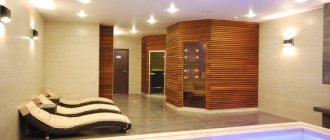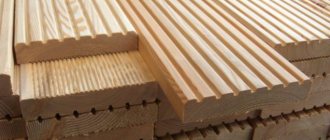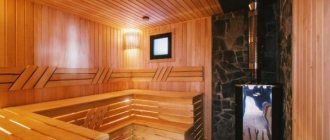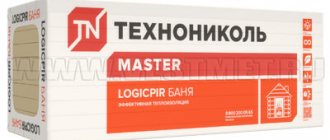Many sensible parents understand how important it is to improve the health of their baby from birth. A very effective, but still rarely used way of hardening and healing is visiting the sauna for babies in their first year of life and older children.
When can you take your child to the bathhouse? How to prepare your baby for the first meeting with the steam room? Which sauna do you prefer—Russian (wet) or Finnish (dry) for hiking with children? Pediatric neurologist of the highest category Tatyana Nikolaeva talks about all this.
How it works
The beneficial effect of the bath is based on the contrast of the temperature effects of water and air on the human body. Under the influence of bath procedures, the skin undergoes deep cleansing. Together with sweat, numerous microbes and other “nasties” are removed, in particular, lactic acid - a companion to fatigue and a feeling of tiredness. That is why after a bath you experience extraordinary lightness, joyful, high spirits.
In the bathhouse, the temperature of the internal organs gradually rises to 38-39°C, which corresponds to a feverish state. At the same time, metabolic processes are sharply accelerated, the body's resistance to the action of pathogenic viruses and bacteria increases, and the immune system is strengthened.
Baths, as you know, are conventionally divided into two types - with moist and dry air. The most famous bathhouse of the first type is the Russian bathhouse with its traditional steam room, where a relatively high air temperature (45-60°C) and high relative humidity (up to 90-100%) are maintained. Among the second type of baths, the Finnish sauna is widely known, where high air temperature (up to 90-100°C) is combined with relatively low humidity (10-15%). For many people (including small children), a “dry” sauna is more comfortable than a “wet” sauna: dry heat is easier to tolerate, because the more humid the air, the more intense its high temperature is felt.
Regardless of the type of bath, after each entry into a hot steam room, it is customary to douse yourself and wash yourself with water, and you can use everything - from a ladle with cool water to an ice hole and wiping with snow.
First visit to the sauna with a baby
When you first visit the steam room, the comfortable air temperature is no more than 80˚C with a relative air humidity of 10%. Usually in the steam room there are special devices that indicate these indicators.
Staying in the steam room should not exceed 3-5 minutes. For the first time, limit yourself to 1-2 minutes, and if the child is very small – 30 seconds.
On your first visit, enter the steam room no more than 1-2 times. After each entry, pour lukewarm water over your baby and if you want to swim, keep the water in the pool warm. Ice showers are excluded - this is an excessive load on the circulatory system.
Important point: For the first visit to the bathhouse, the following scheme is optimal: steam room - dousing - rest (at least 10 minutes). And this scheme must always be followed.
The main criteria for a comfortable bath for a child are a cheerful mood, a pleasing “blush” of the whole body and good sweating.
If you pay all your attention to your child in the bathhouse, it will not be difficult for you to understand whether he is comfortable or not. If the child suddenly turns pale, especially the nose and cheeks, complains of dizziness, headache and weakness - signs of heat stroke.
In children, the body warms up much faster. Therefore, the baby should immediately leave the steam room if he feels unwell. Heatstroke and other troubles can occur if adults forget about the child's comfort while enjoying their own comfort.
If you notice that the baby is not feeling well, take him out of the steam room, lay him on the trestle bed, put a cold towel on his head, and give him a drink.
Is it time for the baby?
Temperature changes in the sauna have a beneficial effect on the body - first of all, it is an excellent training “gymnastics” for blood vessels. When can you take babies to the bathhouse? If the mother did not visit the sauna during pregnancy in a group preparing for childbirth, then it is quite possible to introduce the child to the sauna after a year. Do you want to wait until three, five, seven years, as some experts advise? Great, better late than never. But take into account the peculiarities of the child’s psyche: at two or three years old, for example, during the “three-year crisis”, the baby will probably want to show independence in making any decisions, including visiting the sauna.
In any case, an individual approach is required in this matter! Everything must be adequate: the baby’s mood, the general reaction of the child’s body to the tolerance of different temperature conditions, as well as the heartbeat and skin reaction. Before visiting the sauna, be sure to consult with a modern-minded doctor whom you trust. But every parent should know: if the baby turns pale in the sauna, if he protests extremely violently, immediately take him out of the steam room!
A very important point is the attitude of the parents themselves towards the sauna. Not only in a psychological, but also in a physiological sense: adults understand how important it is to be healthy and hardened, and, overpowering themselves, go to the bathhouse. However, in this case, violence against the body is unacceptable! It is better to find other options for healing procedures. As a rule, the baby inherits from the parents the “readiness” and reaction of blood vessels to stress.
HOW DOES A SAUNA OR BATH AFFECT THE HUMAN BODY?
From a physiological point of view, the main mechanism that causes both therapeutic and side effects when visiting a sauna is the absorption of external heat by the body and the development of heat stress phenomena as a protective response of the body.
In a steam room, the body receives much more thermal energy from the outside than it can remove using heat transfer mechanisms, the main one of which is sweating. The main goal of the functional changes that occur during heat stress is to remove excess heat both from vital organs and from the entire body as a whole. The higher the temperature in the steam room rises, the worse the thermoregulation and heat transfer system works. The longer a person stays at elevated temperatures, the more pronounced the heat stress reaction becomes. Normally, in an adult, throughout the entire session in the steam room, the temperature of the internal part of the body (core) does not exceed 39°C, and the skin temperature does not exceed 42°C. After the end of the bath session, the body’s core temperature returns to its original values after 15 minutes. To improve heat transfer, blood supply to the external parts of the body increases, the heartbeat accelerates, blood pressure rises and breathing quickens. However, the main mechanism for removing excess heat from the body is sweating and the evaporation of sweat from the surface of the body. The largest number of sweat glands involved in thermoregulation are located on the skin surface of the chest and limbs. Sweating in a steam bath or sauna begins at the 5th-8th minute and reaches a maximum from the 12th minute. Important! Sweat must evaporate to cool the body. If you wipe your body in a steam room, apply creams and oils to your skin, and wrap yourself in towels or bathrobes, sweat does not evaporate and the body begins to overheat. Moisture for sweat is generated by blood plasma. The more sweat is released, the smaller the volume of blood plasma becomes and, accordingly, its “thickening” occurs. Simultaneously with the release of sweat, there is a loss of electrolytes (sodium, potassium, magnesium and chlorides) from the blood plasma. Important! To replenish fluid and electrolyte losses during sauna sessions, it is recommended to drink isotonic sports drinks, rather than pure water and certainly not tea.
Get ready for the sauna!
If during pregnancy the mother took classes in preparation for childbirth with a visit to the sauna and swimming pool, then there is no reason to wait a whole year - you can introduce the child to the bathhouse much earlier. I consider the most acceptable age for this to be 3 months. The first 6 weeks of childbirth are a time of adaptation to new living conditions for both the baby and the mother. At this time, there is no need to make any sudden “body movements”.
Up to three months, carry out a unique preparation of the baby for the meeting with the bath
- swimming in a large home bathtub, washing and dousing the child 1-2 times a day with sea water (1 teaspoon of edible sea salt per glass of proven spring water, the so-called “taste of tears”), or Essentuki-4 mineral water. After you have washed and doused your baby with sea water, use gentle tapping movements (with your fists) to help his skin “dry.” Only in this case, the reorganization of healing moisture will be beneficial and “incorporate” into the structure of the skin, which is necessary.
The baby's skin is gradually preparing for bath overloads, and the child himself becomes more resistant to external irritants. It is good to combine douches with full or partial air baths. When a three-month-old baby is adapted, his positive reaction to undressing and dressing is visible (he does not cry, does not turn blue, does not turn pale, does not shrink, his chin does not tremble, does not start to hiccup when changing clothes), when the baby is absolutely healthy and cheerful - hello, sauna!
If your baby has difficulty getting used to the change in climate, you should not go to the sauna with him! In this case, we can only talk about individual, soft contrast procedures in a home “sea” bath, individual massage and gymnastics.
There are children with so-called emotional immaturity who react negatively even to a small change in home environment, or to the visit of their own grandfather. What can we say about the fact that such a child will have to be taken somewhere, “introduced” to other people and children... Such difficult-to-adapt children must first be harmonized at home - build a core of peace and harmony in the child, do not overload him with sound and visual images, toys . When a baby's emotions are unstable, spasms are likely, which can lead to various diseases (and not only the nervous system!). Ideally, every child under three months should be shown not only to a pediatrician, neurologist and orthopedist, but also to a child psychologist and even a speech therapist.
As you can see, the preparatory period for visiting the sauna is very important for a child, do not skip it!
MAIN HEALTH EFFECTS OF SAUNA
According to medical studies conducted in Scandinavian countries and Finland since the early 2000s, the positive effects of sauna use can be achieved with regular use. For example, increased resistance to colds is actually observed in children who visit the sauna at least twice a week for at least 4 months. Regular sauna use under medical supervision can help lower blood pressure in patients with hypertension and increase left ventricular ejection fraction in patients with chronic heart failure. Temporary improvements in pulmonary function in a dry air sauna may provide some relief for patients with asthma and chronic bronchitis. Also, visiting a sauna can also relieve pain and improve joint mobility in patients with rheumatic diseases. Unfortunately, most of the positive effects of visiting a sauna are reversible and disappear when regular visits are stopped.
Baby in the steam room
Your positive emotional attitude towards the sauna will definitely be passed on to your baby! Most likely, there will be no unpleasant surprises. But still, during your first visits, be sure to monitor the fontanel - the soft, non-ossified part of the skull: if the child’s fontanel is swollen, you need to urgently take it out of the steam room!
If your child is breastfed, then, believe me, he will be the most “exemplary” in the steam room - after all, there is a mother nearby, his own warm breast, what else is needed for happiness?
If the baby feels comfortable, he has a good reaction to the steam room - light sweating, a pink body (not bluish, not pale, not purple!), positive emotions. Start with 1 minute in the steam room, no more is needed. For a beginner, 2-3 passes will be enough.
After each visit to the steam room, the baby should be doused with water. Warm, cool or cold - it's up to you. Water of any temperature will be much colder than the skin sensations in the steam room. Therefore, you don’t have to start with an ice shower (although experts and bath lovers prefer truly contrasting procedures!), water at room temperature will already be contrasting.
But pouring or immersing your baby in water is a must if the sauna has a small pool! After all, water has an important functional significance - it removes toxins well, and the skin begins to breathe. That is, in a sauna, dousing with water is necessary not only as a hardening procedure, but also as a hygienic one. For the first time, it is better to douse the baby in the mother’s arms; we place an older child on a cotton towel or on a wooden grid (individual!).
If your baby has been accustomed to being doused with cold water since birth, then do not make an exception in the sauna. And if mom and dad start to wet themselves, the child will be simply happy - a friendly reaction in the company of parents is very important even for a baby, let alone older children.
Losing weight under infrared rays
The infrared sauna also addresses the issue of beauty of one’s own body, which interests all ladies. It has been proven that infrared rays have a negative effect on fat deposits and contribute to the effective fight against excess weight.
A ten-kilometer run can be easily replaced with just one session of infrared therapy. By accelerating blood flow and metabolism, fat deposits are effectively burned in a short time.
The appearance of the skin is transformed: cellulite disappears, it becomes more elastic and smooth. In the infrared sauna you can remove sagging skin and completely renew your body beyond recognition in a few sessions.
A combination of proper nutrition, physical activity and a visit to the infrared cabin will give incredible results in the fight against extra pounds - you can lose a lot of weight in 2-3 months.
Who is not welcome in the sauna?
There are relative and absolute contraindications for visiting the bathhouse. Absolute contraindications are the acute course of any disease
: high temperature (in this case, convulsions and even cardiac arrest are possible in the bath!), sore throat, flu, exacerbation of pyelonephritis, etc. In these cases, home contrast thermal procedures are indicated that normalize blood circulation and reduce temperature: apply hot towels moistened with camphor oil to the baby’s feet and hands, and, on the contrary, put “cold” on the main vessels.
It is also strictly forbidden to visit the sauna in case of acute otitis (today it is catarrhal, tomorrow it is purulent), sinusitis, furunculosis and other purulent inflammatory and infectious diseases
, even if there is no increase in temperature. By the way, for chronic sinusitis, the sauna is very useful in combination with “sea” procedures: the process is already sluggish, heat will not hurt, the sanitization of the maxillary sinuses occurs outward.
You will have to give up the sauna even if you have “blue” congenital heart defects. But not all children and adults with heart problems should be deprived of the sauna: a short, literally a few seconds, stay in the steam room will become a real holiday for the whole body! Don't miss out on this pleasure...
Relative contraindications include pustular lesions and skin diseases
. In this case, the skin has special “parameters”, so the regime for visiting the bathhouse should be more gentle, and dousing is done only with “sea” water (tear-tasting, see above). Many parents whose children suffer from atopic dermatitis (in common parlance - diathesis) know: it is at sea that children improve, their skin becomes less vulnerable.
If a child inherits many moles
, then he needs to be careful with the sun and any thermal procedures. You can visit the sauna (don’t sit in the steam room for a long time!), but you should avoid strong rubbing and rough mechanical impacts on moles.
Who is contraindicated for IR radiation?
As with any procedure, there are a number of contraindications for a course of IR therapy:
- tumors of benign and malignant nature;
- acute purulent processes;
- acute diseases with a sharp increase in body temperature;
- active tuberculosis;
- atheroclerosis;
- tendency to profuse bleeding;
- diabetes.
If you have heart disease, you should definitely consult your doctor about visiting an infrared sauna. Other diseases that are not included in the list of contraindications should not be treated without consulting a doctor.
It is believed that a person who can calmly walk for one hour or walk rhythmically for half an hour can visit the sauna without fear for his health.
IR radiation has a positive effect on the general system of the body: it trains and strengthens it. For diseases of the musculoskeletal system, an infrared sauna is the best alternative to a long walk in the fresh air.
When the bathhouse is the second mother
For children who are often sick
A bathhouse can be almost the only savior from eternal handkerchiefs, coughs and red throats. Soft contrasting and hardening bath procedures strengthen the cardiovascular system, stimulate the immune system, cleanse the skin, and promote the removal of mucus. And if you skillfully use the “correct” broom and medicinal additives (eucalyptus, linden, chamomile, etc.), then the child also receives active inhalation.
But all this will be effective only if the baby has a positive attitude towards the sauna, if you talk about health and hardening in an emotionally positive way. Will a child want to go to the bathhouse if getting ready for it is accompanied by tedious conversations like “Well, if this doesn’t help, then you are completely frail and sick”?
When the acute condition of any cold is over
, the baby is recovering - you are welcome to the sauna! “Farewell” to the disease will be faster and more pleasant.
Today, many medical institutions, including regional children's clinics, offer classes in a children's sauna. First of all, children with muscular dystonia, with injuries and post-traumatic conditions, frequently ill children and asthmatic children
. Yes, the sauna also cures asthma! For asthmatic children, visiting the sauna is not at all contraindicated, as many parents think; rather, on the contrary, the steam room relieves asthmatic attacks well and relieves bronchospasms. But for such children a special regime is needed - with control of breathing rate, heartbeat, etc. It must be provided by medical professionals.
For vegetative-vascular dystonia
The effect of the sauna is beneficial in most cases. But start gradually, using a gentle regimen.
Finally, I must warn you: the expected positive changes in the baby’s health will only occur with regular (for example, weekly) visits to the bathhouse. Once or twice will not bring any benefit. Return there after illness, spring thaw, which does not allow you to go to a dacha with a sauna, or, conversely, a dacha holiday, which does not allow you to visit a sauna in the city, after everyday troubles and worries, to say again: “Hello, sauna!”
Tips for visiting a bathhouse with a child
- Observe basic hygiene requirements yourself and demand the same from others. The sauna needs to be ventilated every 1.5-2 hours.
- A wet floor is dangerous; it’s easy for a child to slip on it.
- Do not walk barefoot; a hot steam room is sterile from a bacteriological point of view, which cannot be said about other rooms. Both viral and nasty fungal diseases are dangerous for your feet.
- If you have a swimming pool, check how often the water is changed. Very often, children become infected with helminths (worms) in non-specialized saunas. Therefore, thoroughly wash your baby’s entire body with soap and a washcloth.
- Before the first visit, do not wet the baby or wash his hair. A headdress is required - a light felt or woolen cap.
- You should not enter the steam room on an empty stomach or after a heavy meal. Breast milk doesn't count! Also teach your children to refrain from eating for 1.5-2 hours after the bath. Do not snack between visits to the steam room.
- Before leaving the bathhouse, if the baby really asks, give him an apple or carrot. Take with you green tea (in a thermos), plain mineral or boiled water, natural juices, fruit drinks - they will well replenish fluid loss.
- You need to drink healthy drinks while resting between visits to the steam room; this promotes active sweating, which is very important.
- Always end a visit to the sauna with a wash - to wash off the “dirt and sweat” from the baby. Don't forget soap, shampoo, washcloth, towels.
- The most trained child should not be in the steam room for more than 8-10 minutes.
Also, don’t forget to take to the bathhouse (except for slippers, a cap, bath accessories) a warm robe, a change of underwear, sheets for sitting in the steam room, diapers, toys, and books.
Whether your child can go to the bathhouse is up to you to decide. The main thing is that the child does not have health-related contraindications. Children should see your joy, your delight in visiting the bathhouse. And her visits will become a healthy and useful habit for your family.
From the lives of famous bathhouse lovers
Alexander Sergeevich Pushkin truly appreciated the “splendor of the Russian bath” and studied the “bath” customs of other nations. The poet became addicted to the bathhouse from childhood, and did not miss going to the lyceum: every Saturday there was a bathhouse, that was his routine.
It is believed that it was largely thanks to hardening and regular visits to the bathhouse that the famous Russian commander Alexander Vasilyevich Suvorov became a strong and resilient person. The magazine “Zamechatel” noted in 1842: “In the bathhouse, Suvorov withstood the terrible heat on a shelf, after which ten buckets of cold water were poured on him...”.
Fyodor Ivanovich Chaliapin recalled: “My father and I washed and steamed for hours, until we were tired, until we were exhausted. And then, when I left home, I remember: no matter what city I came to, the first thing I did, if I had at least one nickel in my pocket, was to go to the bathhouse and there endlessly washed myself, lathered myself, doused myself, steamed, scalded, and again started all over again." (S.E. Rosenfeld. “The Tale of Chaliapin”).
What do we offer?
Family saunas with warm and cozy rooms encourage all members of a friendly family to spend time in harmony and enjoy joint relaxation. You can visit our sauna with children of any age - many interesting entertainments, for example, a water slide, will help bring the whole family together. Adults can also relax by playing Russian billiards or American pool. In addition, you can enjoy a variety of delicious dishes - the menu of our bath club includes Russian and European cuisine.
This is interesting
In Rus', baths were built not only to keep the body clean, but also to harden, preserve health, youth and beauty. Even newborn babies were bathed in a bathhouse in warm water with a small amount of lye instead of soap made from straw ash (more delicate than wood); they began to steam the baby in the bathhouse early with a birch broom, after having previously lubricated the baby’s skin with a thick layer of yeast and wrapped him in a diaper. Now it’s funny to read about this: running water and hot water, comfortable baths and showers quite cope with the hygienic and cosmetic functions of the bathhouse. Nevertheless, the bathhouse, having withstood serious competition with apartment bathrooms, is experiencing a kind of revival. And not only in Russia!
Prepared by Olga Nikolaeva
Article from the July issue of the magazine.
CONTRAINDICATIONS FOR VISITING THE SAUNA
- Any acute inflammatory process (including a cold).
- Headache, any other pain, fever, injuries, unhealed wounds and damage to the skin and mucous membranes.
- Oncological diseases.
- Traumatic brain injury (1 year after the event, unless otherwise specified by a physician).
- Stroke (cerebral infarction) or transient ischemic attack (1 year after the event, unless otherwise specified by a doctor).
- Myocardial infarction (6-8 weeks after the event, unless otherwise specified by the doctor).
- Unstable form of coronary heart disease.
- Aortic stenosis.
- Cholinergic urticaria.
- Systemic lupus erythematosus.
- Multiple sclerosis.
- Toxicosis of pregnant women.
- Peripheral neuropathies (diabetes, alcoholism, leprosy, Guillain-Barré syndrome)
- Diseases that impair sweating.
- Large area of cicatricial changes on the skin surface after burns.
- Orthostatic hypotension.
- Uncompensated hypertension.
- Patients whose condition may worsen as a result of a decrease in cardiac output and a decrease in blood pressure.
- Patients with decompensated cardiovascular diseases.
- Patients with any diseases of the circulatory system after intense physical activity of any kind (including sex).
- Patients with any diseases of the circulatory system after taking alcohol and/or drugs.
- Cardiac arrhythmias.
- Convulsive disorders.
- Presence of a pacemaker.
- The presence of surgical metal implants in the body.
- Silicone breast implants.
- Hemophilia and other hemorrhagic diseases.
- Diabetes.
- State of alcohol or drug intoxication.











